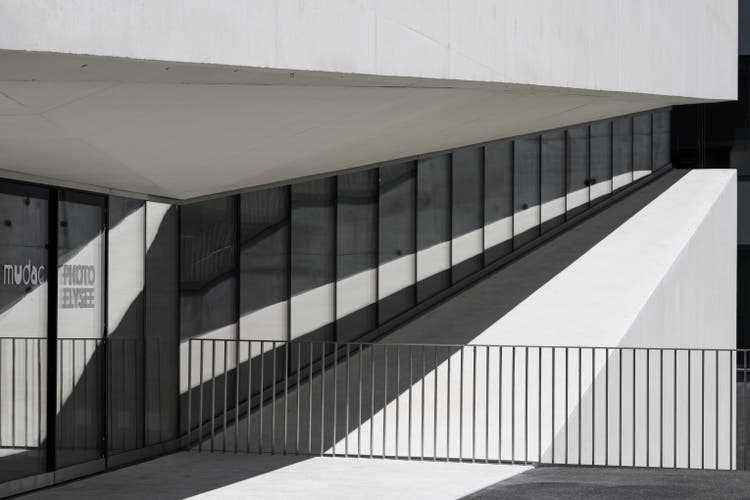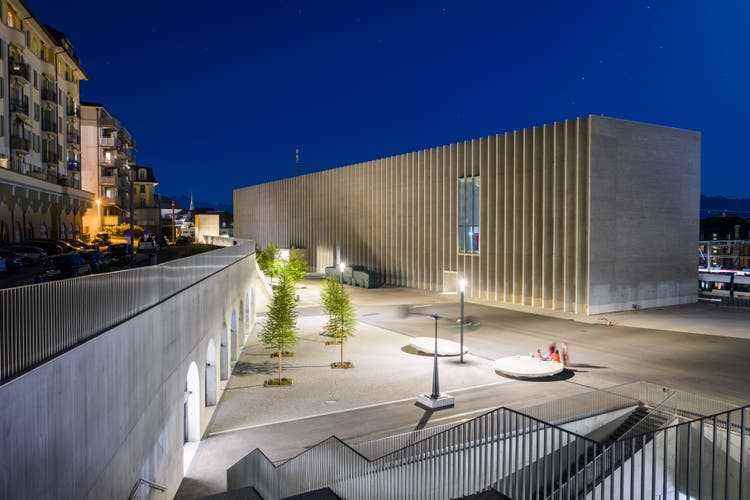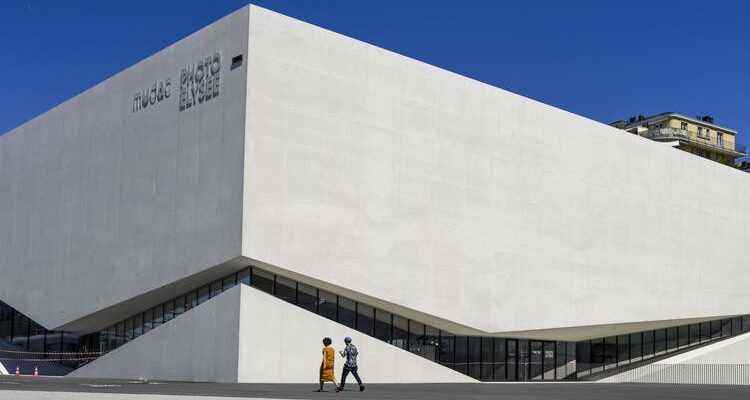Lausanne opens the new art district called Plateforme 10. The architecture is convincing, the first theme less so. Visitors can watch live how an SBB car is sprayed.
Imposing fair-faced concrete: a new museum complex is located in the immediate vicinity of Lausanne train station.
Lausanne is currently not making things easy for guests traveling by train: the station is being massively expanded and is one big construction site. Anyone who leaves the building is guided past large partition walls. Apart from the information signs that were put up for the duration of the work, there is little to indicate that an architecturally sophisticated gem has been pounded out of the ground in the immediate vicinity.
The eye reacts all the more happily when you have left the hustle and bustle of the station behind you. A mighty monolithic brick building towers up along the tracks, flanked by a square of Mediterranean proportions and a Helvetic sense of order. The real gem only becomes visible at second glance: a fair-faced concrete building characterized by playful geometry, which appears intimate and imposing at the same time. Next to it, the trains pull into the station as they always have.
All of this is Lausanne’s new art quarter called Plateforme 10, where the authorities are particularly fond of the word “quarter”. In fact, it is more than just a museum that is now opening: the complex brings together five cultural institutions in Vaud – including the Cantonal Museum of Art (MCBA), the Cantonal Museum of Design and Contemporary Applied Arts (Mudac) and the Cantonal Museum of Photography (Photo Élysée). There are also two foundations. The entire area, which was previously inaccessible to the public, is the size of five football pitches. The exhibition area of the three museums is 6300 square meters, which means that they have twice to three times as much space as before.
Do the museums retain their autonomy?
The road to Plateforme 10 was rocky: in 2008, the people of Vaud rejected the plans for an art museum on the lake by a narrow majority. The SBB site at Lausanne train station was chosen as the new location, but objections delayed the project. The groundbreaking ceremony took place in 2016, and the MCBA was inaugurated in 2019. However, it is only with the opening of the photo and design museum that the art quarter unfolds its full effect.
The fact that three important museums can be visited at the same location is intended to enable visitors to take tours that they would probably not have considered before – when the institutions were spread all over the city. “The museums are independent of each other, but they work closely together,” says Patrick Gyger, general director of Plateforme 10 and thus patron of the entire structure. It is now up to him to refute the fears that could be heard in advance that the individual museums could lose autonomy and thus their identity due to the new mega-structure.
The first three exhibitions show what this collaboration looks like in concrete terms. However, the respective curators succeeded in implementing it: The MCBA shows works of art that testify to the profound change caused by train stations, bridges and tracks from the middle of the 19th century. The viewer can imaginatively travel on the train – and in time.
Read first, then visit – or vice versa
The Photo Élysée, which for conservational reasons is located in the dimly lit basement of the new building, also deals with the more than 150-year history of the railway. Historical photos are presented – including those from the construction of the tunnels and bridges crossing the Alps – some of which developed such iconographic power that they were able to influence the painting of the time. The journey through time stops in Paris and New York, shows union struggles around the railroad and touches on contemporary alternative culture.

The building that houses the Design and Photo Museums required some engineering skills: the upper part stands on just three pillars.
The Mudac Design Museum is particularly creative in its approach to the subject: the exhibition organizers have commissioned three authors to write a so-called “Roman de Gare” (in German, it’s more like a penny novel). Anyone who has read it – for example on the train to the museum – will constantly be reminded of scenes from the book in the exhibition. The tour includes, among other things, the work of an artist who creates cities out of suitcases, or a wall installation reminiscent of Merklin railways. A rare spectacle awaits visitors who flock to the new art quarter at the weekend for the (free) public opening in the Mudac: behind the glass facade facing the tracks, a graffiti artist will spray-paint a train car – with the blessing of the SBB, mind you.
«Four hours from Paris and Milan»
With the opening of Plateforme 10, Vaud is fulfilling statutory mandates such as highlighting the canton’s cultural heritage or encouraging creative activity. But the view goes far beyond that: just a look at the press kit, which praises the Lausanne location as “less than four hours by train from Milan and Paris”, shows the claim. But even if the reference to European cultural metropolises seems rather pretentious, the Plateforme 10 is likely to develop into a new fixed star in the Swiss museum sky – not least because the canton, which has been financially solid again for a good 15 years, paid a lot for the new buildings. The MCBA cost 84 million francs, the Mudac and the Élysée as well as the outdoor facilities even devoured 102 million francs. Private donors contributed a good third. The annual operating budget of Plateforme 10 is 27 million Swiss francs.
As if it were a chef d’oeuvre that is still waiting for the final brushstroke, the new Lausanne art district is not presenting itself in its final version at the moment. The museums are finished, but numerous trees still have to be planted and a watercourse built on the forecourt. What is particularly striking is that an ideas competition has only just ended for the signal box that is to be redesigned. One day it will serve as the actual portal of the new district. But sometimes the beginning comes at the end. That also somehow fits the train theme.

